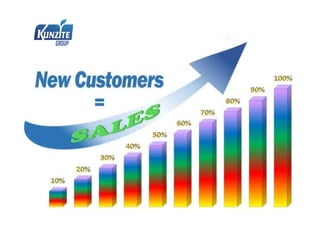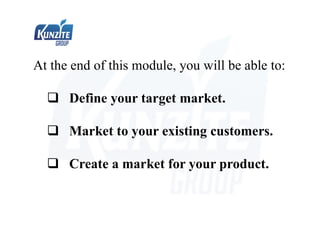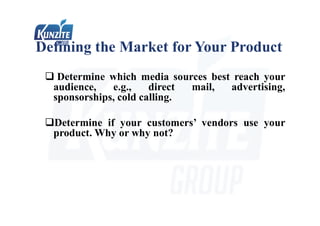How to find new customers and increase sales
- 3. At the end of this module, you will be able to: Define your target market. Market to your existing customers. Create a market for your product.
- 4. Define your target market
- 5. Market to your existing customers
- 6. Create a market for your product
- 7. Answer these questions to define your target audience: Who will buy your product or service? What value proposition are you offering? What is your competition offering its customers? How are you different than your competition? What is the best way to reach your audience? How will you get repeat business? Who are potential customers that have the problem your product solves? How frequently will your product be purchased, e.g., one-time purchase, quarterly purchases, etc.? Understanding Your Target Audience
- 8. Define your target market to ensure you spend your valuable resources on prospects who are more likely to buy your product/service. Create a product profile: • Look at the characteristics of your current customers and find similarities. These similarities will help define who is buying your product. • What type of company has a need for the product you are selling? • Who are the decision makers? Should you pitch your products to the IT director or CFO? Defining the Market for Your Product 8
- 9. Determine who is in direct competition with your current customers. Can they use your product? Why or why not? Consider smaller market segments: • Consumer vs. industrial. • Private vs. public companies. • Short sales cycle vs. long sales cycle. • Create niche target markets, and customize your marketing materials to each niche. Defining the Market for Your Product
- 10. Determine which media sources best reach your audience, e.g., direct mail, advertising, sponsorships, cold calling. Determine if your customers’ vendors use your product. Why or why not? Defining the Market for Your Product
- 11. Analyzing metrics. Analyze and track how you obtained your current customers and continue these efforts, such as advertising, interest in articles written by your company, marketing materials, websites, and relationships. Cold calling. Find the right contact name. Knowing a name gets you further than asking for the “IT director.“ Call a certain number of prospects each day or week. Generating Sales Leads 11
- 12. Networking. Attend business and social events, e.g., tradeshows, civic organizations, chambers of commerce, industry associations, and open houses. Connect with friends and colleagues on LinkedIn, Facebook, and Plaxo. Creating product champions. Work with customers to create case studies, testimonials, or product endorsements. Post on your website. Ask customers to share your success story with others. Generating Sales Leads
- 13. Teaming with affiliates. Co-market with affiliates or vendors that offer complementary services, e.g., newsletters, brochures, websites. Using your Website. Update your web pages regularly to allow search engines to find your data more easily. Use key phrases instead of single words so your website appears first in searches. Consider paying for search engine promotion. Advertising. Determine if it’s worth advertising directly against your competition. Advertise for free or pay per click using sites such as LinkedIn, Facebook, or Twitter. Generating Sales Leads
- 14. Sell to existing customers. They are the easiest to sell to because they already trust you. To increase sales to existing customers: Bundle products. • Offer customers multiple services for a special/reduced price. Customers are happy to consolidate services with one vendor as long as they are satisfied with your service. Selling More to Existing Customers
- 16. Look for up-sell opportunities. • If the customer already purchased a service from you, offer the warranty or the first software upgrade at a discounted price. Offer a discount. • Discount the products you know your customer is interested in or tell them when the product will be on sale. Selling More to Existing Customers
- 18. Reward customer loyalty. • Offer loyal customers a gift with purchase or free product with 10 purchases. Offer free samples. • Let your customer try it before they buy it. Create a desire within the customer to purchase the product. Selling More to Existing Customers




















